CALCode Quarterly Spring 2024

 Stoyan Bumbalov
Stoyan Bumbalov
Welcome to the spring 2024 edition of the CALCode Quarterly newsletter. As the newly appointed executive director of the California Building Standards Commission (CBSC), I would like to briefly introduce myself. My first day with CBSC was May 1, and I have been trying very hard to get up to speed so I can dive into the important work we do – administering the adoption and amendment of the California Building Standards Code, Title 24 of the California Code of Regulations (Title 24). A little about myself: I am a former California state employee who worked in code development with the Department of Housing and Community Development for many years. From there, I went to Washington state, where I was the managing director of the State Building Code Council, an organization similar to CBSC. You can read more about my history and experience in the biography posted on our About Us webpage.
Here at CBSC, there’s a lot going on, and the articles below will provide details. Here’s what you can find in this edition of CALCode Quarterly:
Staff spotlights: I am not the only new face in the office. CBSC recently backfilled a Staff Services Manager I (Specialist) position and we are happy to introduce Lara Paskins. Lara comes to us from the Occupational Safety and Health Standards Board where she had a leadership role in their rulemaking process. Also, Tim Freeman has joined the team as an Associate Architect. Because Tim worked in the private sector as an architect and consultant, he brings a unique perspective to CBSC’s operations.
CALGreen recognition: This year, CBSC is celebrating 15 years since the publication of the first edition of the California Green Building Standards Code, Part 11 of Title 24 (CALGreen). So, it was an honor to recently receive two prestigious awards from different organizations that actively promote sustainable and green building in California. See below for more.
Connections: Our robust education and outreach program is dedicated to connecting with our constituents, code users and policymakers who have similar missions. Since the beginning of the year, staff have attended numerous events to share Title 24 and code adoption cycle updates, as well as information about participating in the public rulemaking process. Check out the Education and Outreach sidebar for details.
New codes: We are rapidly approaching the effective date for the supplements to the 2022 edition of Title 24. The supplements contain new regulations and amendments to existing codes and will become effective on July 1. PDFs of the published supplements can be found on our Codes webpage. In the last two newsletters, we provided information about the new mandatory embodied carbon reduction measures and voluntary bird-friendly building design codes in CALGreen. In this CALCode Quarterly edition, updates to the electric vehicle charging regulations are outlined and links to additional resources are provided. After reading the article and perhaps viewing the code, check your knowledge with our online quiz!
Cycle status: The 2024 Triennial Code Adoption Cycle is in full swing, with Code Advisory Committee meetings and public comment periods already happening and upcoming in the next few months. This is the cycle when the adoption of model codes occurs, as well as the development of new codes required by California laws and mandates. You can follow the process on our Rulemaking webpage, and be sure to subscribe to the email list to receive notices of public meetings and comment periods.
That’s it for this issue; I hope you enjoy it and perhaps learn something new. I look forward to working with you as we develop the codes in Title 24 for a safe and sustainable built environment in California.
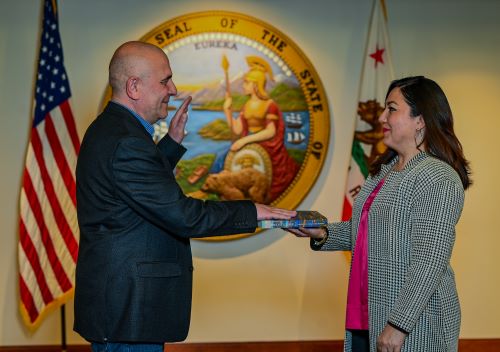
New CBSC Executive Director Stoyan Bumbalov is sworn in by Department of General Services Director Ana Lasso
Feature Articles
The California Building Standards Code, Title 24 of the California Code of Regulations (Title 24), contains the building codes that must be used when designing or constructing buildings throughout the entire state. As such, it influences every design and construction practice—engineering, architecture, procurement, the building trades—as well as building management. And because there are continuous advances in all of these areas, the building codes must be regularly updated to keep up with the latest technologies and methods to keep buildings efficient, safe and sustainable.
Every three years, Title 24 is updated in three ways:
First, the updated model codes that form the basis of Parts 2, 2.5, 3, 4, 5, 9 and 10 are required to be adopted by appropriate state agencies.
Next, state agencies make California amendments to those model codes in order to meet the requirements of state law by eliminating conflicts or adding regulations that aren’t provided in the model codes.
Finally, amendments or additions are made to the California-only regulations in Parts 1, 6, 8, 11 and 12 to comply with new mandates in law or directives from the administration.
To learn more about the parts of Title 24, visit the Codes page of our website to see a list and the Resources page to view guidebooks and educational videos.
The California Building Standards Commission (CBSC) administers the process of adopting and amending Title 24. Staff work with adopting and proposing state agencies to ensure the process results in sensible and usable building codes. This process is called “rulemaking” and you can learn more and follow activities on our Rulemaking webpage.
Right now, CBSC is in the beginning phases of the 2024 Triennial Code Adoption Cycle. Here’s a summary of recent cycle activities.
Code change submittals from state agencies were separated into two groups:
The first group includes proposals for Parts 3, 4, 5 and 11. Note that the National Electrical Code, which is the basis for the California Electrical Code (Part 3 of Title 24), is published by the National Fire Protection Association one year before the other model codes. It has to be proposed for adoption by the responsible state agencies within one year of publication, so that step was completed a year ago. All other rulemaking steps will happen during this triennial cycle. Submittals for Part 3 proposals will have a “23” instead of “24” in the file name.
The second group contains the proposals for all other parts of Title 24, including the parts based on International Code Council (ICC) model codes: Parts 2, 2.5, 9 and 10.
Remarkably, in this cycle there is also a proposal to adopt building standards into the currently vacant Part 7 of Title 24. The State Fire Marshal (SFM) is proposing to adopt portions of the 2024 edition of ICC’s International Wildland-Urban Interface Code (IWUIC), with California amendments, into the California Wildland-Urban Interface Code (CWUIC). Presently, wildland-urban interface (WUI) regulations exist in several different locations in Title 24: the California Building Code (Chapter 7A), the California Residential Code (Section R337) and the California Fire Code (Chapter 49). If approved and adopted, these WUI regulations in Title 24 will be moved to Part 7.
WUI regulations in the Natural Resources Code (Title 14) and the Public Safety Code (Title 19), and state laws addressing WUI in the Public Resources Code, Government Code, and Health and Safety Code will either be duplicated, referenced or summarized in Part 7. Having all of the laws and regulations in one location will make it easier for designers, contractors, homeowners and enforcement officials to find and apply them. SFM’s rulemaking package will be reviewed by the Building, Fire and Other Code Advisory Committee (CAC) at a public meeting in July. Comments in support of or opposition to new proposals are always welcome.
As this triennial code adoption cycle progresses, we encourage you to participate in public meetings and comment periods for the disciplines about which you have some expertise and experience. The next CAC meetings will be:
Accessibility (ACCESS) on June 4
Building, Fire and Other (BFO) on July 9 – 11
Structural Design/Lateral Forces (SDLF) on July 16 – 17
and
Health Facilities (HF) on July 30
The public comment periods for proposals heard at these meetings will be in late July for ACCESS and in September for BFO, SDLF and HF.
The public comment period for the proposals already reviewed by the Green Building (GREEN) and Plumbing/Electrical/Mechanical/Energy (PEME) CACs (for Parts 3, 4, 5 and 11) is currently in progress and will close on July 1.
Note: CBSC does not administer public comment periods for the California Energy Commission (CEC), which has proposed code changes for the California Energy Code (Part 6 of Title 24) and CALGreen (Part 11) this cycle. CEC runs its own rulemaking activities that can be followed by visiting the 2025 Building Energy Efficiency Standards webpage.
To receive notices regarding public comment periods or meetings, please sign up for our mailing list using the link on our Contact webpage.
In the last CALCode Quarterly, the nine-point criteria (Health and Safety Code (HSC) Section 18930) was briefly outlined. As we begin public comment periods and hold more Code Advisory Committee meetings, let’s take a closer look at how to interpret and apply the criteria when evaluating code proposals.
Criteria #1 – The proposed building standards do not conflict with, overlap or duplicate other building standards. Great care must be taken to avoid duplication in Title 24 so that designers, builders and building officials are not confused about which code to use or enforce. Just in case, each part of Title 24 has a section in the Scope and Administration chapter that directs code users to apply the more restrictive requirement if a conflict is found.
Criteria #2 – The proposing state agency or agencies must have express jurisdiction to promulgate the regulations. Because of this requirement, all regulations that are proposed also include a citation of the law that gives authority to propose the regulation to the state agency.
Criteria #3 – Proposed regulations must be in the best interest of the public. HSC Section 18930 lists several areas of public interest, including fire safety, building performance, accessibility and environmental concerns.
Criteria #4 – The regulations must be reasonable and fair, and not arbitrary or capricious. Using this criteria, an objection could be made if the proposed measures would affect one group of California residents negatively while benefitting another group; or an argument could be made that a code proposal was not based on sufficient reasoning or research.
Criteria #5 – There must be a benefit that outweighs the cost of implementing the proposed regulation. State agencies that propose regulations must conduct research and determine if there is a fiscal or economic impact on the affected public. This determination is assessed at public meetings and during public comment periods when the proposals are reviewed.
Criteria #6 – Proposed regulations must be specific and easily understood to be applied correctly. Input provided by subject matter experts at workshops, public meetings or during public comment periods can help state agencies write better regulations by correcting proposed language that might be vague or ambiguous for code users.
Criteria #7 – This criteria addresses the incorporation of national model codes and reference standards. Additionally, sometimes the state agency has to amend the national standard because it is inadequate for California’s needs, or it has to write its own, because a national standard does not exist. All of this must be documented in the proposal.
Criteria #8 – All proposed building standards should be presented in a consistent format to avoid confusion and promote ease of use of the code.
Criteria #9 – If a proposed building standard promotes fire and panic safety, it has to be approved by the State Fire Marshal (SFM). This criteria requires that all proposed standards be reviewed by SFM, and if fire and panic safety are impacted, then the State Fire Marshal must provide written approval of the proposal.
Every new code proposal must meet all of these criteria, and any objection or recommendation by a Code Advisory Committee or action by the commission other than “approve” must cite one or more of the criteria. It is recommended that comments from the public also cite a criteria.Since 2009, the California Green Building Standards Code, Part 11 of Title 24 of the California Code of Regulations (CALGreen), has been a leading example for green building codes throughout the nation and the world. The California Building Standards Commission (CBSC) is proud of its efforts and accomplishments in developing sustainable building regulations that improve the quality of life in the state now and into the future.
In May, CBSC had the honor of accepting two awards recognizing CALGreen’s status as a leader in green building standards.
Green Technology’s Pioneer Award
Green Technology is a nonprofit organization based in California that provides forums and other resources for public- and private-sector sustainability stakeholders and decision makers. Its goal is to facilitate the implementation of building and transportation solutions efficiently and effectively through sharing information peer to peer, agency to agency, and between private-sector solution providers and stakeholders.
Every year in May, Green Technology convenes the Sustainable Facilities Forum in Sacramento to bring stakeholders together to learn about and share new technologies, best practices, and developments in government regulations for commercial occupancies. They also celebrate leaders and pioneers in the industry who have accomplished significant feats in sustainability.
On May 9, the Pioneer Award was presented to CBSC’s Associate Construction Analyst Enrique M. Rodriguez for his contributions to the development of CALGreen since 2009. Enrique has been a part of the team that researches green building practices, holds workshops and public meetings, and then writes the nonresidential building standards in CALGreen. This award recognized Enrique specifically for his contribution to expanded electric vehicle charging requirements in the 2022 CALGreen Supplements, including a new compliance pathway that gives owners and builders an additional option to comply with the code. Learn more on our CALGreen webpage.
During his acceptance speech at the forum, Enrique said, “I am truly honored to receive this Pioneer Sustainability Award from Green Technology. It really means a lot to me and to all my colleagues at CBSC. The CALGreen code is celebrating its 15th anniversary this year and, fortunately, I have been part of this exciting journey since the beginning. As most of you know, CALGreen became the nation’s—and possibly the world’s—first green sustainability building code back in 2009. Fifteen years later, it is still evolving and going strong. It’s inspiring that the CALGreen code…has helped in promoting California’s green movement.”
To see more about Enrique’s award and other winners, visit Green Technology’s online magazine.
 |
 |

Enrique M. Rodriquez with Green Technology President Keith Miller and his very excited CBSC colleagues: Cynthia Biedermann, Pamela Maeda, Timothy O'Malley, Laura Mills, Tim Freeman, Lara Paskins and Beth Maynard
U.S. Green Building Council’s Policy Leadership Award
On May 23, the U.S. Green Building Council of California (USGBC-CA) board and the California Green Building Conference committee presented the 2024 Policy Leadership Award to CALGreen and the American Institute of Architects-California (AIA-CA). This award recognizes the collaborative leadership efforts of CBSC, the Division of the State Architect (DSA), and AIA-CA to create embodied carbon reduction building standards in CALGreen. It is partnerships such as these that help move the fifth-largest economy in the world forward in protecting the environment.
USGBC is the developer and administrator of the LEED (Leadership in Energy and Environmental Design) building certification program, and its California division has a mission to transform the state’s built environment into a more sustainable, resilient and equitable place for all.
At the award ceremony during the California Green Building Conference in Los Angeles, CBSC’s Supervising Architect Irina Brauzman accepted the award alongside Winston Thorne of AIA-CA. The award recognizes the work and expertise of architects, engineers, material developers, sustainability consultants, building scientists, code officials and many more who participated in the CALGreen Carbon Reduction Collaborative (CCRC). The CCRC is a workgroup co-founded by CBSC and DSA—led by former CBSC Executive Director Mia Marvelli and State Architect Ida Clair—to garner input from professional, nonprofit, industry and state agency stakeholders, including representatives from USGBC and other sustainable building champions. This collaborative model helped create buy-in from affected entities in advance of the formal code adoption cycle process. The newly adopted building standards are intentionally modest and make use of materials and resources already on the market at no increased cost. The CCRC will continue to improve and strengthen the carbon reduction regulations in CALGreen, as well as to provide educational resources to code users.

Ben Stapleton (USGBC), Winston Thorne (AIA-CA), Irina Brauzman (CBSC) and Sarah Vasquez (AIA-CA) with the Policy Leadership Awards at the California Green Building Conference.
In the last two editions of CALCode Quarterly, we provided an overview of the new mandatory embodied carbon reduction and voluntary bird-friendly regulations. In this edition, we will focus on updated electric vehicle (EV) charging regulations.
The expansion of charging availability is essential to meeting goals to place more EVs on California’s roadways in coming years. While a lot of charging opportunities are made available voluntarily, having mandatory requirements in the California Green Building Standards Code, Part 11 of Title 24 of the California Code of Regulations (CALGreen), ensures that charging stations and infrastructure are provided statewide for new construction, as well as qualifying additions and alterations. In CALGreen, the Building Standards Commission (BSC) has authority for most nonresidential occupancies, including state colleges and universities. Other agencies have authority for public schools and community colleges, medical facilities and residential occupancies, and this information is detailed in the code.
Here is a summary of important changes made by BSC during the 2022 Intervening Code Adoption Cycle for nonresidential occupancies under its authority. These regulations go into effect on July 1, 2024.
First, alternative compliance methods were added to give designers and builders more flexibility for meeting the code’s EV requirements. One method is called “EV capable spaces” and the other is the “power allocation method.” As the names imply, one method focuses on the spaces provided with different types of EV charging equipment or infrastructure, while the other allows the use of power in kilovolt amps (kVA) as required for each specific site. These two compliance pathways allow for different combinations of EV infrastructure, supply equipment and charging stations to best suit the needs of the project.
The updated CALGreen code now has two tables that show how to comply with either method, and they are designed to be equivalent while providing many different options for compliance. The 2022 CALGreen Supplement Guide provides in-depth explanations and use cases (examples) of how to meet the requirements for parking lots with different numbers of parking spaces. It also supplies the calculation used to convert kVA to kilowatts to assist with using the power allocation method of compliance.
Here is a sample of Table 5.106.5.3.1
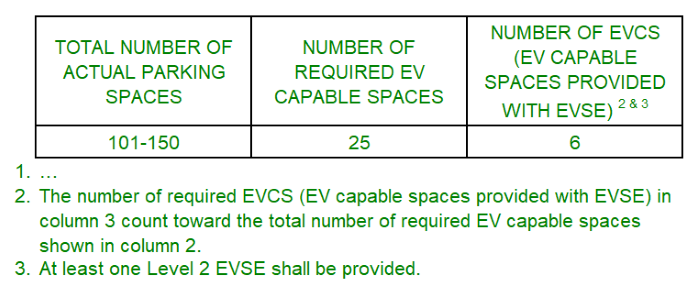
It is important to know the following terms when using this table:
- EV capable spaces are spaces that have the infrastructure to install future chargers.
- EVCS is an EV charging station where EV supply equipment resides. You can charge an electric vehicle there.
- EVSE is electric vehicle supply equipment, meaning the infrastructure and equipment in an EVCS that charges a vehicle, such as the raceway, transformer, cable and plug that connects to the car.
Note that Footnote #2 of the table states that the number of charging stations in column 3 counts toward the number of capable spaces in column 2. So, in this example, there would be six charging stations and then 19 remaining EV capable spaces (i.e., subtract column 3 from column 2…don’t add them together unless you want to provide more than the minimum!). Footnote #3 indicates that at least one EVCS shall have Level 2 EVSE.
CALGreen regulations have evolved along with the emerging variety of methods used for charging, so there are various methods to meet the requirements. The code now allows two Low Power Level 2 receptacles to equal one EV capable space without EVSE, and one direct current fast charger (DCFC) equals five EV capable spaces (or independently EVCS with Level 2 EVSE). The choice for how to meet the required numbers lies with the designer or owner, and may depend on the building use. For instance, fast chargers are good for retail locations with short dwell times, while Level 2 chargers are better for offices or other locations with long dwell times.
Along with new construction, mandatory EV charging regulations will apply to qualifying additions and alterations. There are some triggers for a project to comply with the measures, and some exceptions, too. The code authors recognize that not all projects can accomplish the installation of EV charging and also take into account the existing exceptions and the cost associated with certain EV installations, so that is why they’ve included triggers and exceptions.
Other EV charging updates:
- Added two new occupancies—manufacturing facilities and office buildings—to the medium- and heavy-duty vehicle EV raceway and electrical panel requirements currently in place for grocery, other retail, and warehouse facilities.
- Aligned the voluntary measures in the appendix chapters with the mandatory sections for EV capable spaces and power allocation method options. The percentages of spaces did not increase, though. They remain the same as in the 2022 code that is currently in effect.
- A footnote requiring at least one installed Level 2 charger was added to the voluntary EV compliance method tables to align with the mandatory footnotes.
For more information and details, refer to the 2022 edition of CALGreen and the supplements, as well as the 2022 CALGreen Supplement Guide. We’ve also produced a short EV Charging video that summarizes the changes and provides a couple of examples of how to comply.
Please call or email CBSC if you have a specific application question: (916) 263-0916 or cbsc@dgs.ca.gov.
Take the CALGreen EV charging codes quiz to test your knowledge! Use the link or QR code:
forms.office.com/g/Pj8A9wGPKD or

Lara Paskins has joined the California Building Standards Commission (CBSC) as a Staff Services Manager I (Specialist). She brings a myriad of skills and expertise to the position, including extensive rulemaking and project management experience. For instance, as manager of the Regulations Unit for the Occupational Safety and Health Standards Board (OSHSB) during the COVID-19 pandemic, Lara and her team worked closely with Cal/OSHA’s research and standards engineers and attorneys to pass one of the first COVID-19 worker protection standards in the nation.
CALCode Quarterly asked Lara a few questions to help us get better acquainted:
What prompted you to apply for your position with CBSC?
“I was…impressed by the amount of information on the CBSC website and the various tools, guides and videos put forward by the commission to educate the public and multiple stakeholder groups about the rulemaking process, different code cycles and Title 24. It was obvious that there was a great deal of pride, hard work and consideration that was driving this organization.
However, it wasn’t until I started working at CBSC that I was able to witness the strong work ethic, expertise and passion embodied in every commission employee. The icing on the cake has been experiencing a culture (cultivated by the leadership of Kevin Day) that values its staff and understands the importance of a maintaining a work/life balance.”
Now that you’ve learned a bit about CBSC’s mission and activities, what are you looking forward to accomplishing here?
“I love puzzles and to me, rulemaking is a jumbo 10,000-piece puzzle. The process is deliberate and involves many parts that need to fit together in a very specific way. In my prior rulemaking experience, I had to juggle 10-15 different projects at a time. At CBSC, I am now part of a rulemaking team responsible not only for the 12 distinct parts of Title 24, but the multiple components submitted by various proposing and adopting agencies. I’m excited to participate in this Herculean effort.”
Anything else you’d like to share?
“I love discovering new music, finding old music that’s new to me, and attending intimate concerts. This passion started while serving on the Cal Poly San Luis Obispo concerts committee where I got to meet and work with acts like Toad the Wet Sprocket, Public Enemy, Rage Against the Machine, Sammy Kershaw and Tito Puente. After I graduated college and moved to San Francisco and Seattle, my fervor for cutting-edge music grew and I made musical exploration and concert-going a regular and integral part of my life. In Seattle, I began my support of, and community involvement with, KEXP—the best radio station in the world.”
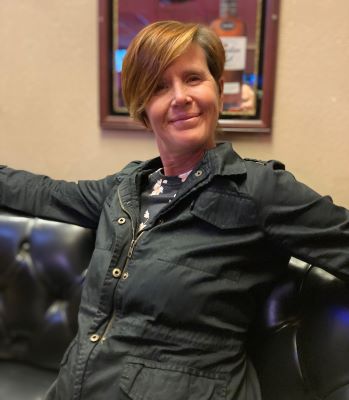
Tim Freeman is CBSC’s newest Associate Architect. He will be focused on the continued development of expanded sustainability regulations in CALGreen, specifically for electric vehicle charging and other transportation solutions. Tim’s experience as a practicing architect gives him a unique perspective on how the regulations in Title 24 are used and applied in the field.
CALCode Quarterly checked in with Tim to get to know him better:
What prompted you to apply for your position with CBSC?
“I had been in the private sector for 25 years and wanted to make the shift to providing service at the state level. Reading the description for the position with CBSC inspired me to rethink my role as an architect. I realized that, though the scope of work is different from my direct experience in architectural projects, I could provide a service and contribution to CBSC and its effort to provide common-sense solutions both in the code as well as with education and outreach.”
Now that you’ve learned a bit about CBSC’s mission and activities, what are you looking forward to accomplishing here?
“Each commercial project of which I’ve been a part has included requirements for electric vehicle parking and bike parking at some level. As the code has evolved, I’ve needed to provide solutions to future needs as well as what is currently required. This has required me to adjust plans and layouts to accommodate and efficiently provide the required space for future expansion of these parking needs. Beyond CALGreen requirements for projects, continually evolving requirements and technologies in heating and air conditioning, lighting, and building envelope products have made it necessary to continually look at each project with a fresh perspective. I look forward to using this experience in contributing to the administration of California’s building code adoption process and using my experience in the architecture industry to provide a technical resource to constituents, other agencies and my colleagues at CBSC.”
What’s your most interesting or impactful experience or contribution so far in your career?
“Though I’ve managed and contributed to larger commercial projects, the real satisfaction and interest for me came from providing creative solutions for homeowners to address needs that are unique in every project. This has included a two-story accessory dwelling unit to maximize the space available and integrate with the backyard recreation area while staying within the constraints of the jurisdiction. Another project involved construction of a mountain cabin using concrete and steel in an area severely impacted by the threat of wildfires.”
Anything else you’d like to share?
“As my children were growing up, I was proud to be a mentor to kids as part of my role on the adult advisory council of a local youth leadership group. I’ve also provided professional advice to my local Fire Safe Council regarding measures to harden homes, structures and properties from the threat of wildfires. This included construction technologies preferred by the State Fire Marshal as well as other technologies that provide a level of protection, but that may not be currently approved by the State Fire Marshal. Beyond building technologies, I’ve advised on measures in defensible space around buildings and structures to further protect assets on the property. Lastly, since beginning my position with CBSC, I’ve been impressed with the kindness of every fellow staff member, the base of knowledge throughout the office, and the collaborative effort to accomplish our mission. An office such as this is what gets the work done, and I’m happy to be a part of it.”
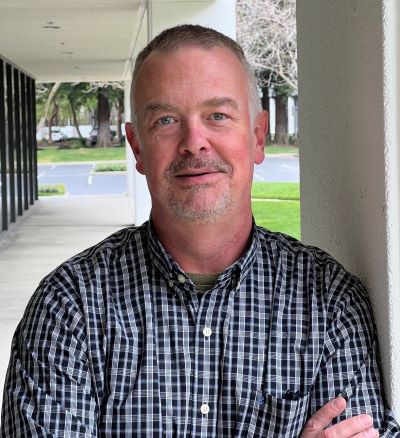
New Publications
The 2022 CALGreen Supplement Guide has been published and is available to download. This guide provides the text of the new CALGreen regulations, then explains the intent and provides examples, and offers plan intake and inspection suggestions.
If you are interested in learning more about the new CALGreen regulations, here are some additional resources:
Videos – Embodied Carbon Reduction and EV Charging
Fall 2023 newsletter article – Bird-friendly Building Design
Summer 2023 Newsletter Article – Embodied Carbon Reduction
This CALCode Quarterly – EV Charging Feature Article
The 2022 Title 24 Supplement Code Changes summary was published in March for the regulations that go into effect on July 1. It is available to view as a webpage or as a downloadable PDF.
CALGreen is fifteen!
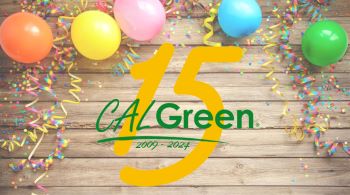
Education and Outreach
Building Safety Month 2024
Each year, the International Code Council promotes building safety during the month of May. This campaign is designed to raise awareness of the importance of building codes and enforcement officials in keeping the public safe where they live, work and play. To help promote Building Safety Month, CBSC obtains a declaration from the governor and places an eye-catching banner on its homepage carousel. State employees also see a message about Building Safety Month on every paycheck issued during May.
General Services Administration Climate Change Speaker Series
The United States General Services Administration, Office of Architecture and Engineering, invited staff from the California Department of General Services to their Climate Change Speaker Series on February 15. CBSC’s Supervising Architect Irina Brauzman and DSA’s Principal Architect Eric Driever spoke to the group about the history of CALGreen, as well as stakeholder engagement for development of the new embodied carbon reduction regulations that become effective July 1. Irina and Eric also explained the three pathways by which public- and private-sector developers can achieve compliance for occupancies under the Building Standards Commission and Division of the State Architect’s authority. Watch this short video to learn more about the new regulations.
CALBO Annual Business Meeting and Leadership Academy Luncheon
CBSC is always happy to engage with the state’s building officials, both to garner input on code development and to help them understand and enforce the state’s building standards.
On April 23, then-Acting Executive Director Kevin Day and Supervising Architect Irina Brauzman attended the California Building Officials (CALBO) Annual Business Meeting in Indian Wells, California. Kevin sat on the state agency panel in the morning, and Irina presented information regarding the new embodied carbon reduction regulations (effective July 1) that same afternoon.
On May 13, recently appointed Executive Director Stoyan Bumbalov and Deputy Executive Director Kevin Day attended CALBO’s Building Officials Leadership Academy luncheon in Sacramento. This event is another great opportunity for CBSC’s leadership to connect with experienced and new building officials who are on the front lines of code application and enforcement. Stoyan and Kevin talked about code adoption cycle activities and then answered questions from the attendees. For more information about current building standards development, visit CBSC’s Rulemaking webpage.
Sustainable Facilities Forum
The nonprofit organization Green Technology convenes a forum every year to bring together private- and public-sector policymakers and industry leaders in the development of new products and technologies to help advance a sustainable and green built environment in California. On May 9, several members of CBSC’s staff hosted a table at this year’s forum to provide information about the CALGreen code. They were Education and Outreach Coordinator Laura Mills, Associate Construction Analyst Enrique M. Rodriquez, Associate Architect Tim Freeman, and Staff Services Manager I Lara Paskins.
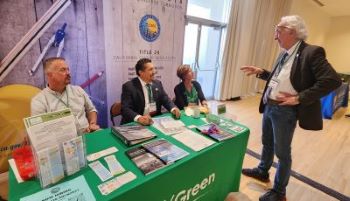
Tim Freeman, Enrique M. Rodriquez and Lara Paskins with Green Technology President Keith Miller
Also, in the morning Laura and Enrique gave a CALGreen update presentation to interested code users.
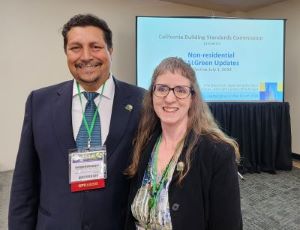
Ending the day on a celebratory note, Green Technology presented Enrique with its Pioneer Award (see separate article). Enrique’s wife and four of his six children, as well as additional CBSC staff, joined the celebration. It was truly a grand occasion to honor a valuable member of the CBSC team.
ICC Tri-Chapters Meeting in Santa Cruz
On May 17, Supervising Architect Irina Brauzman attended the International Code Council’s tri-chapters meeting and presented new code updates as well as information about the code adoption cycle status and opportunities for public participation. This meeting is another great opportunity for CBSC to speak directly with stakeholders who are affected by the building standards in Title 24 and to encourage them to attend CBSC public meetings or participate in public comment periods. The input of code users and subject matter experts is essential in creating sensible and usable building standards.
